
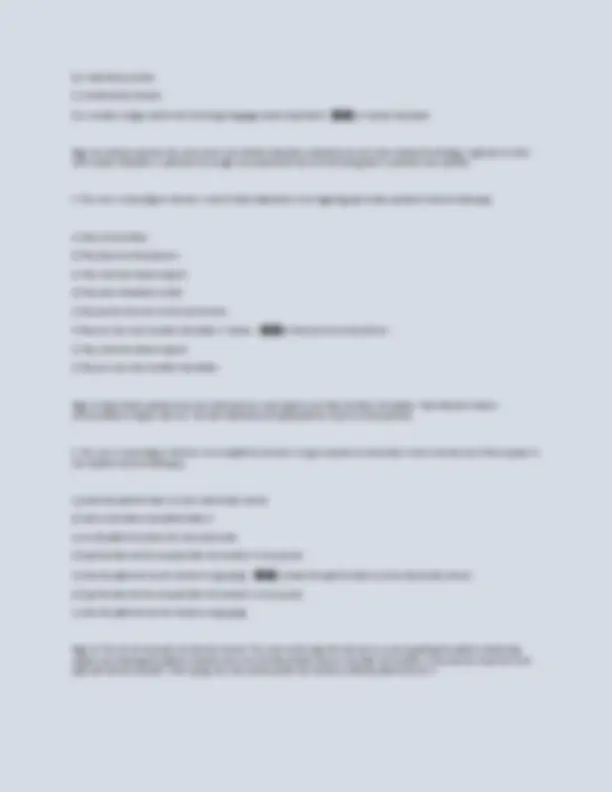
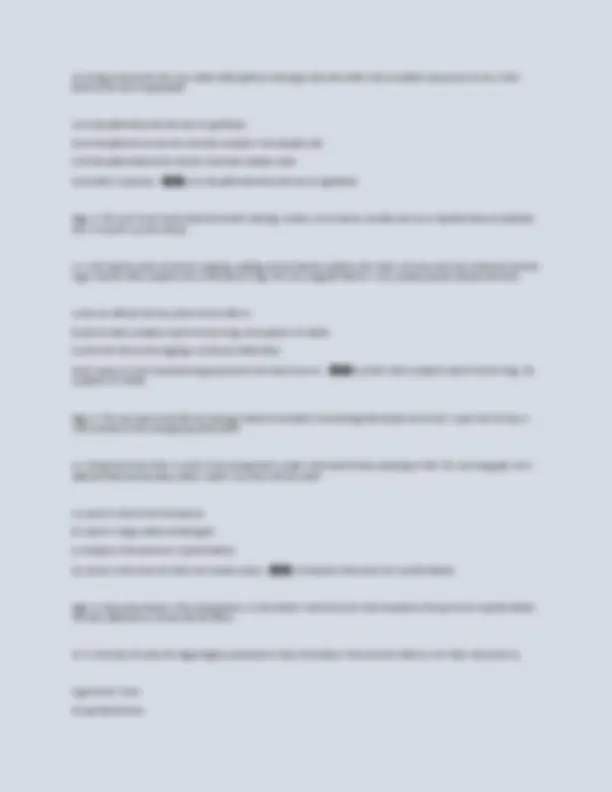
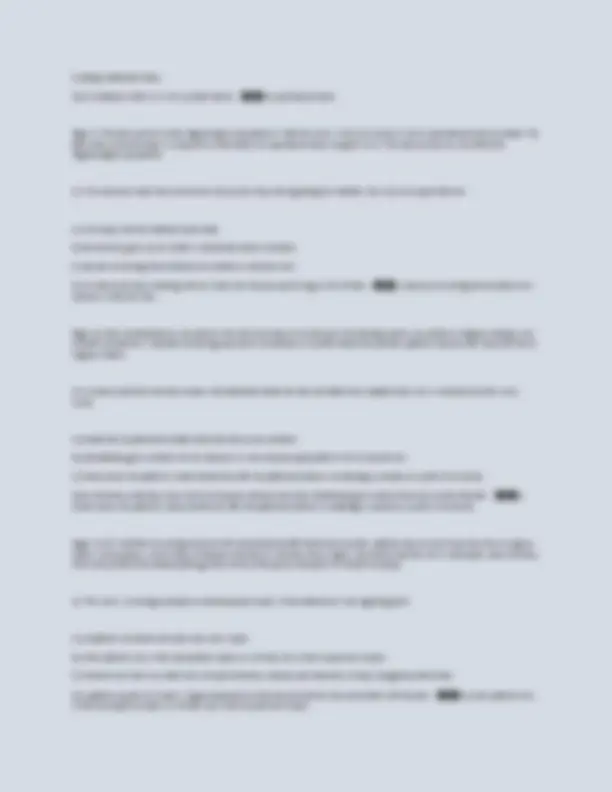
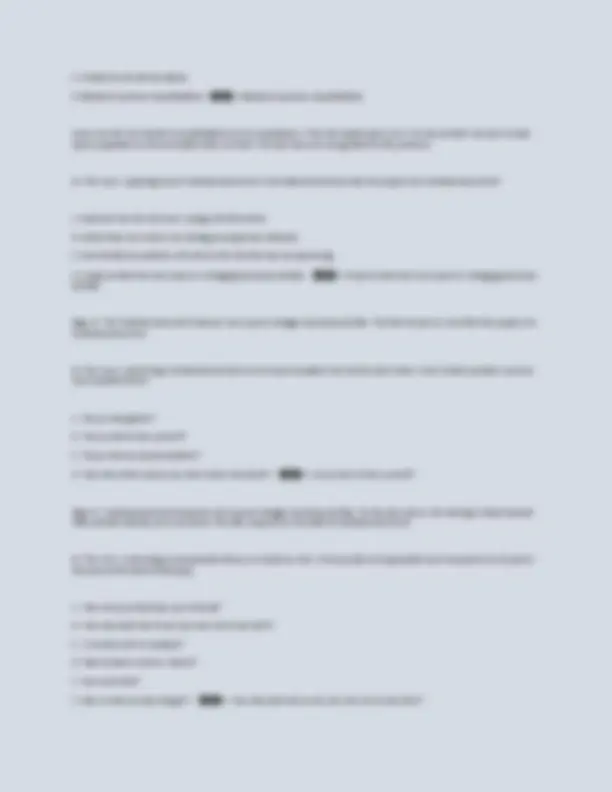

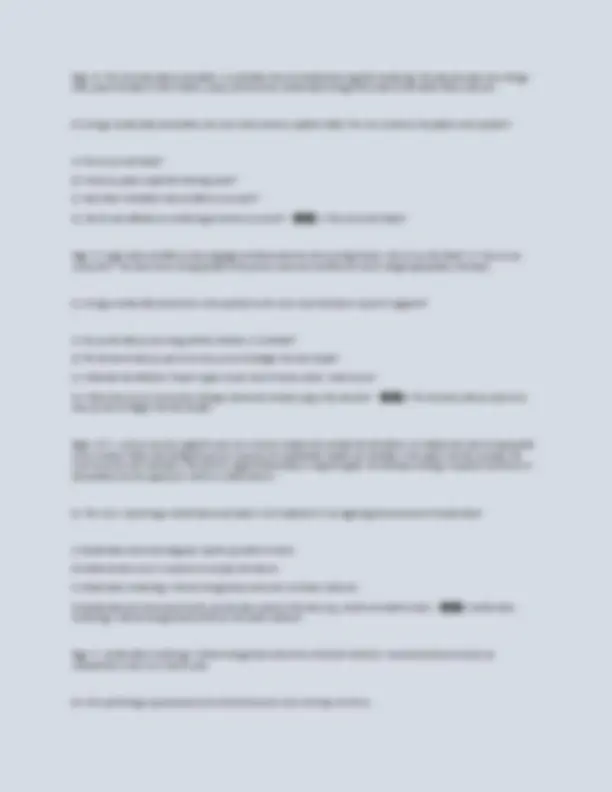
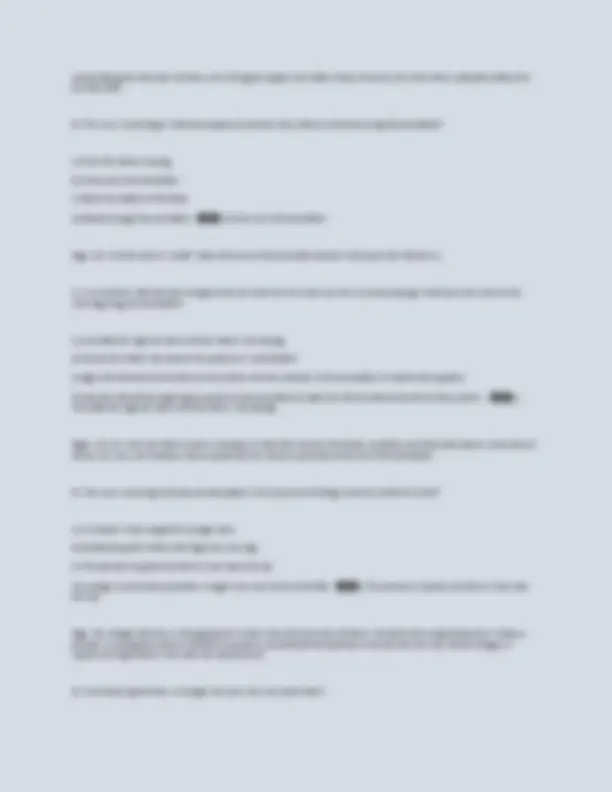
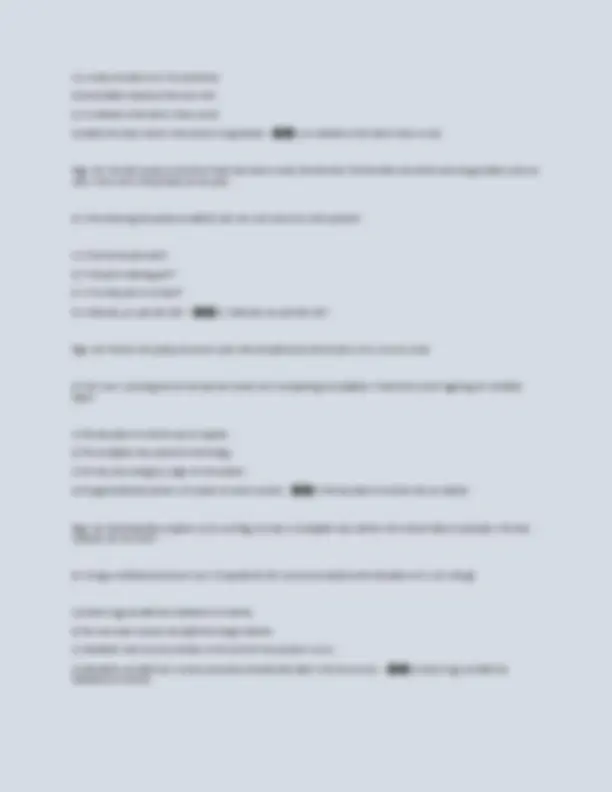
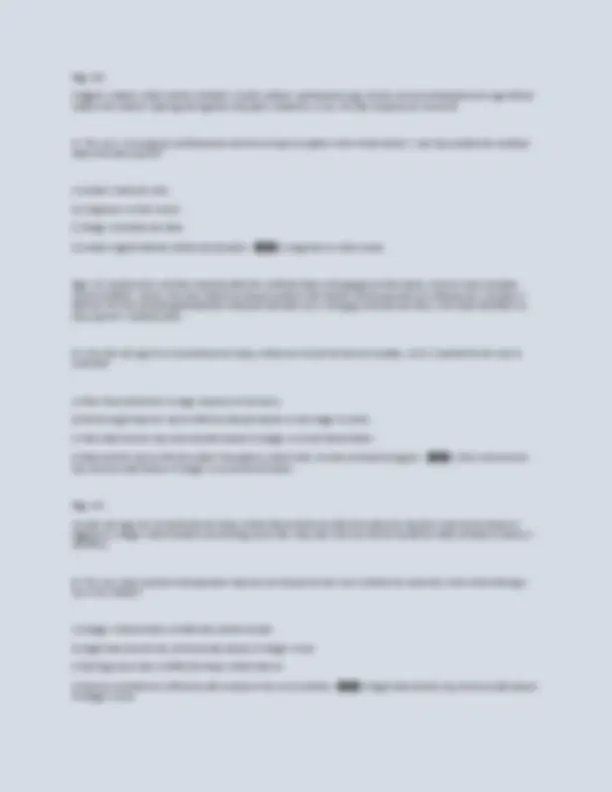
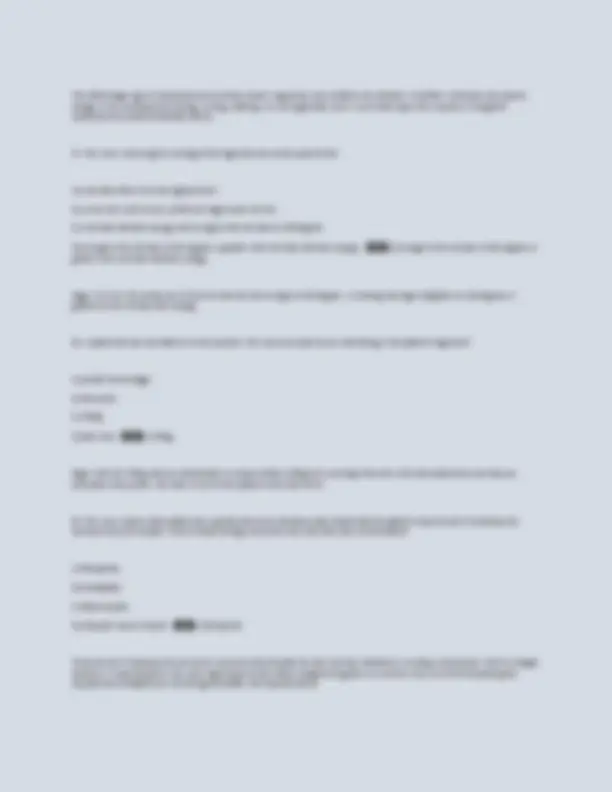
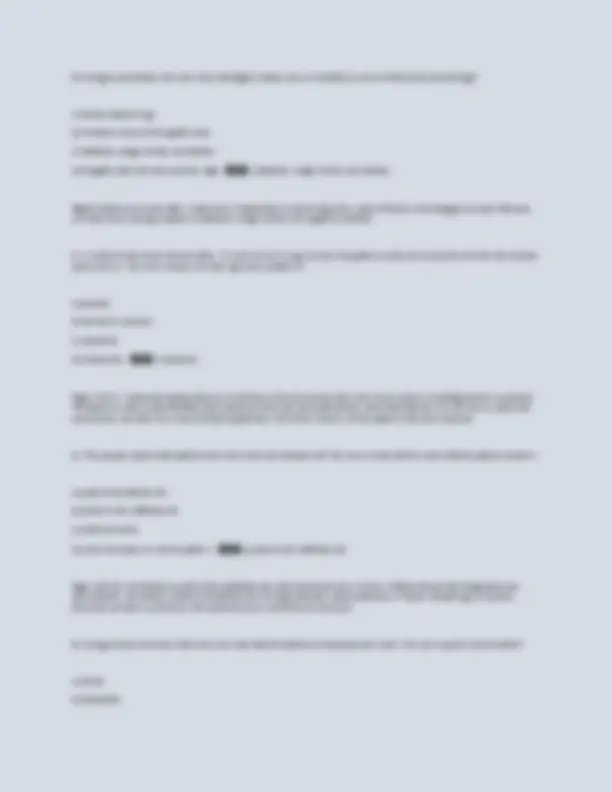
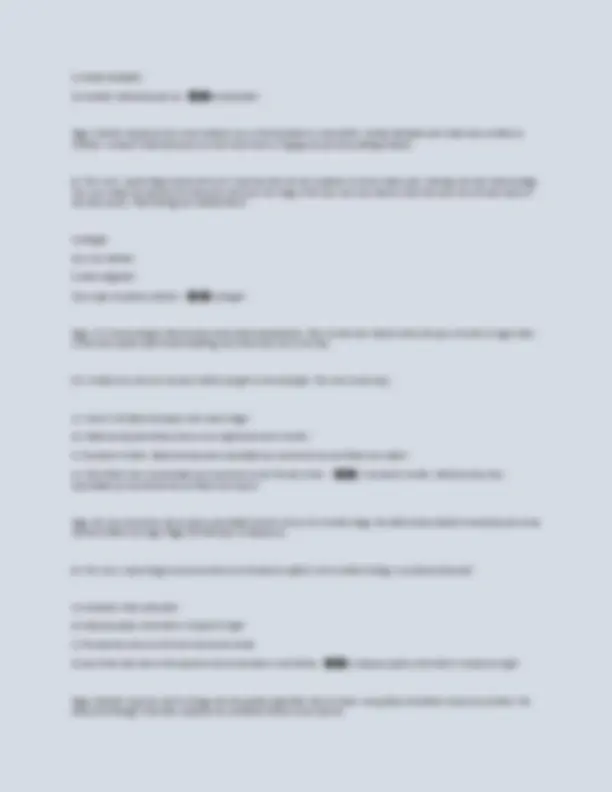
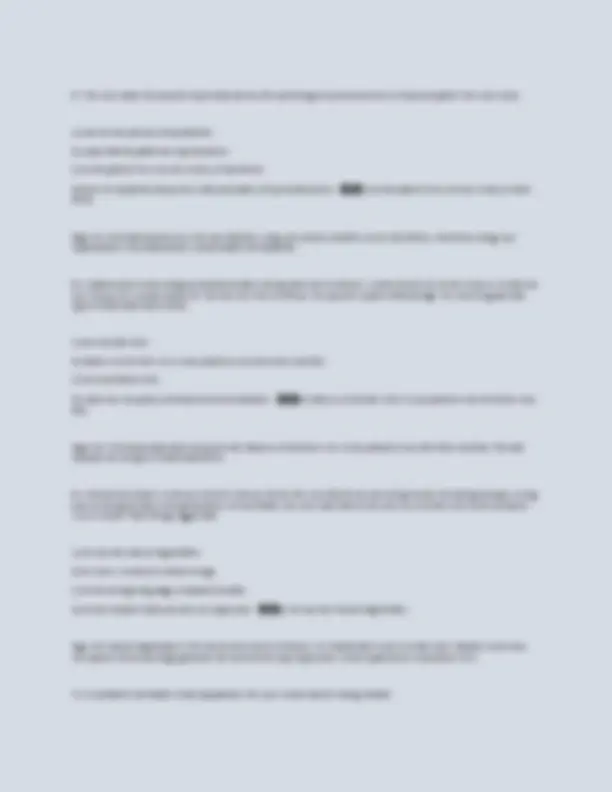
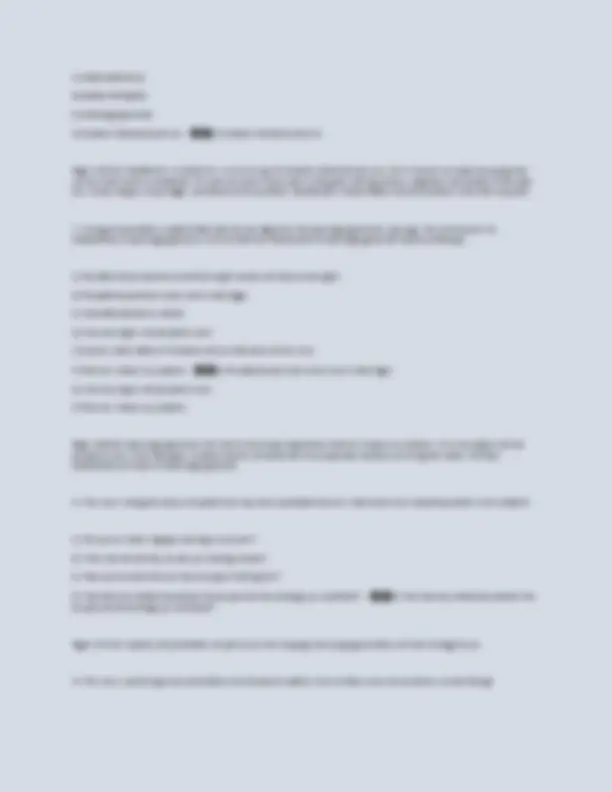
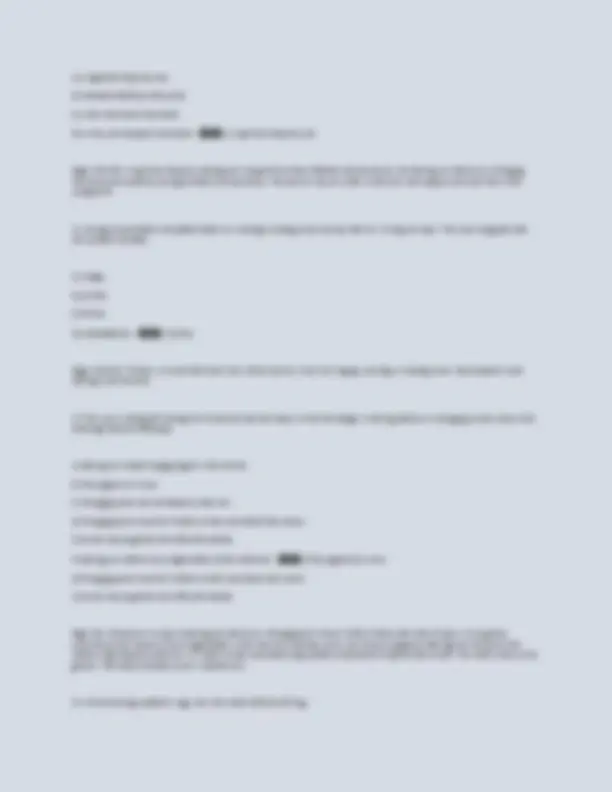
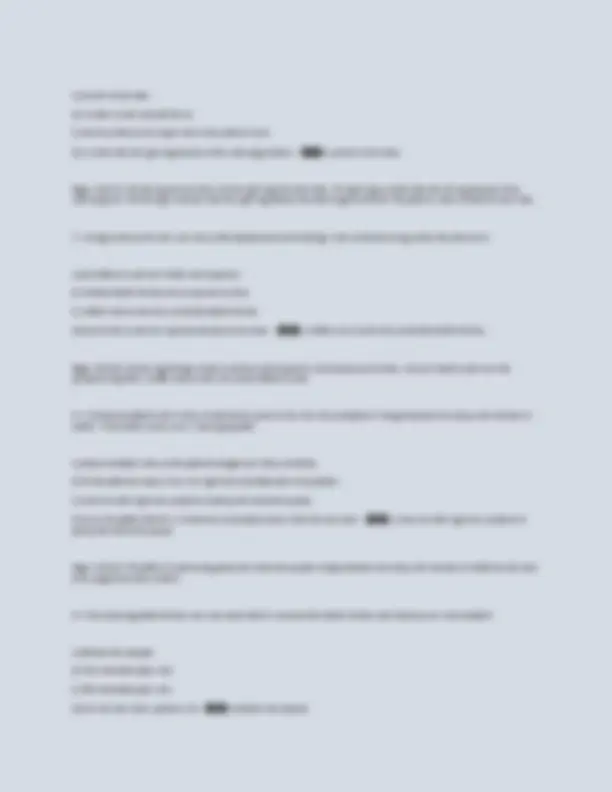
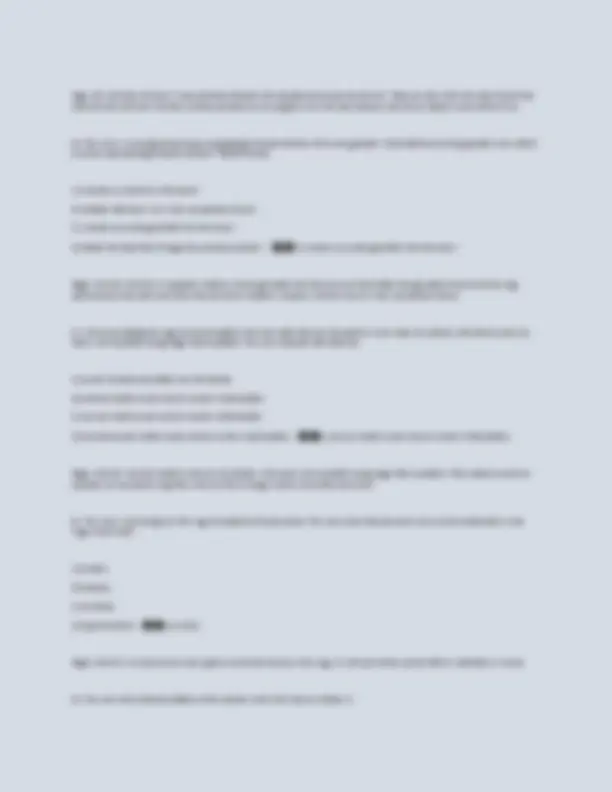
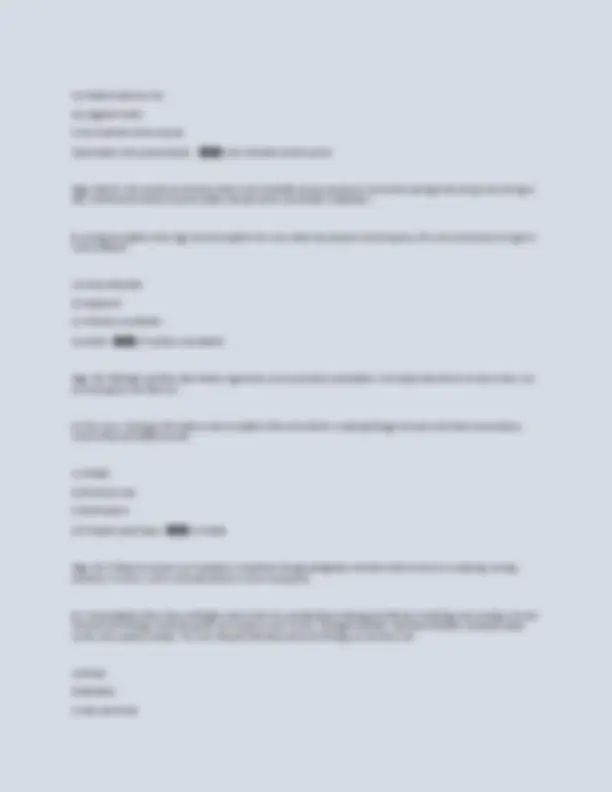
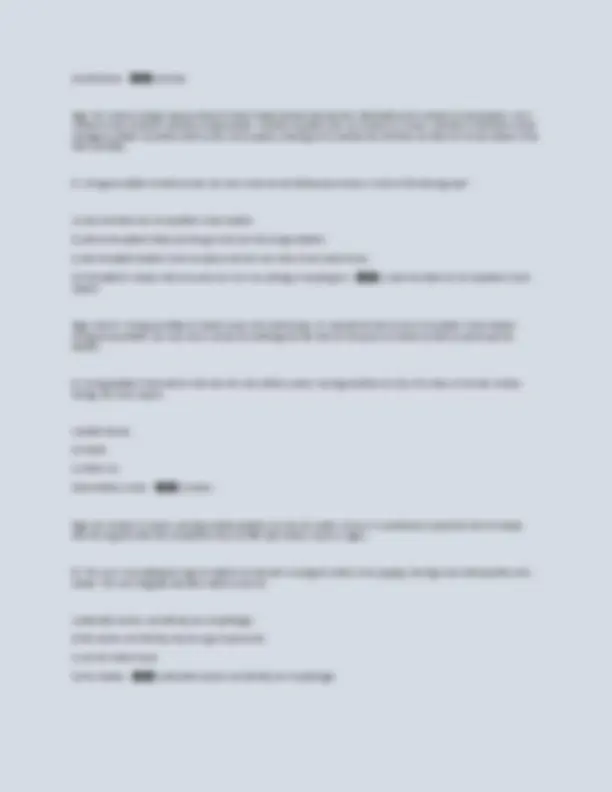
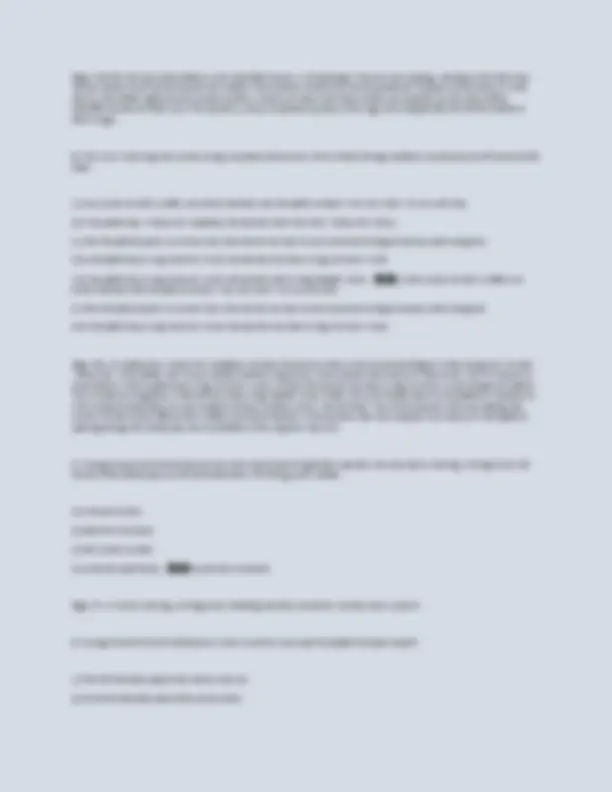

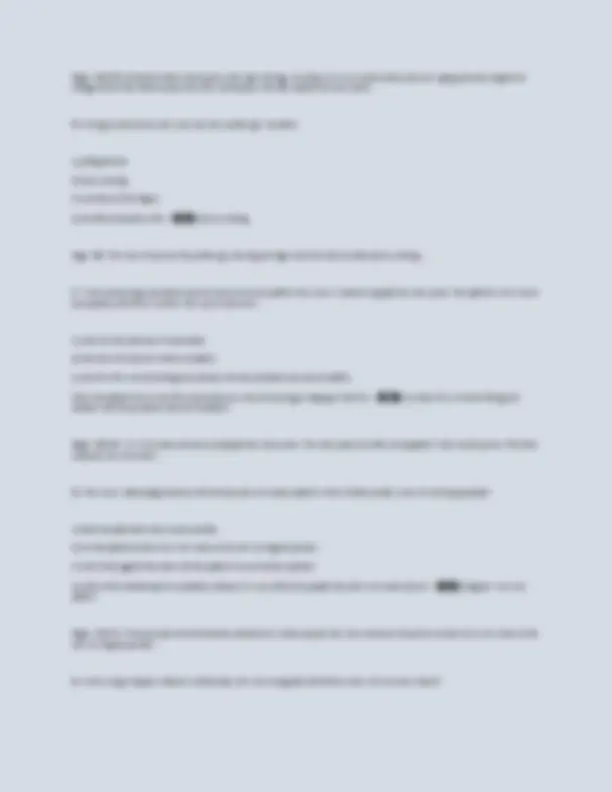
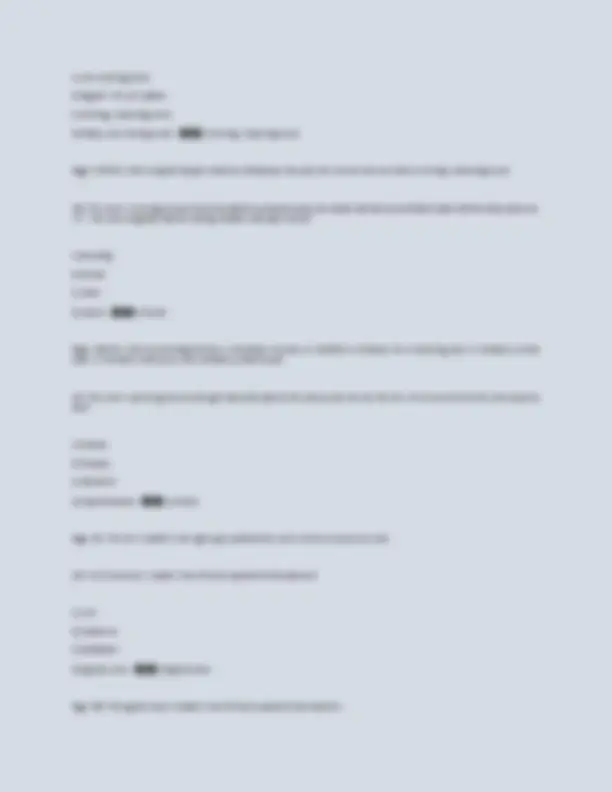
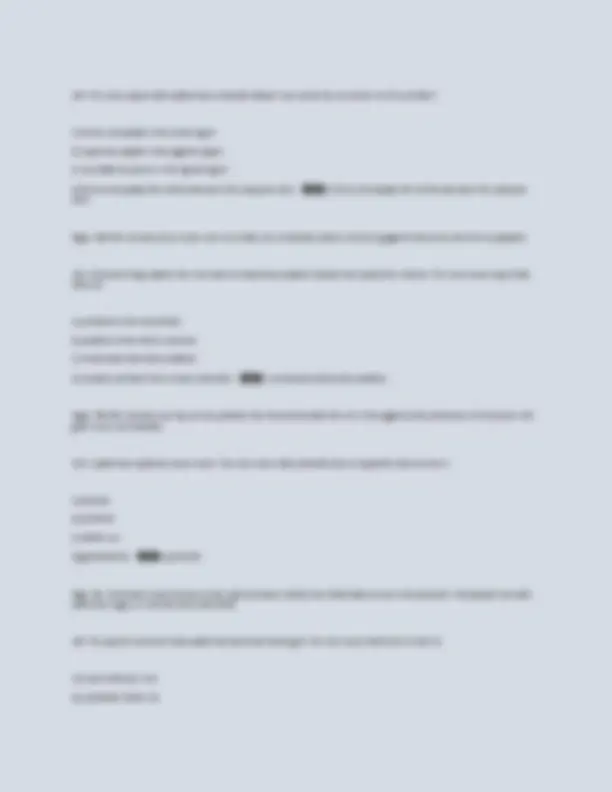
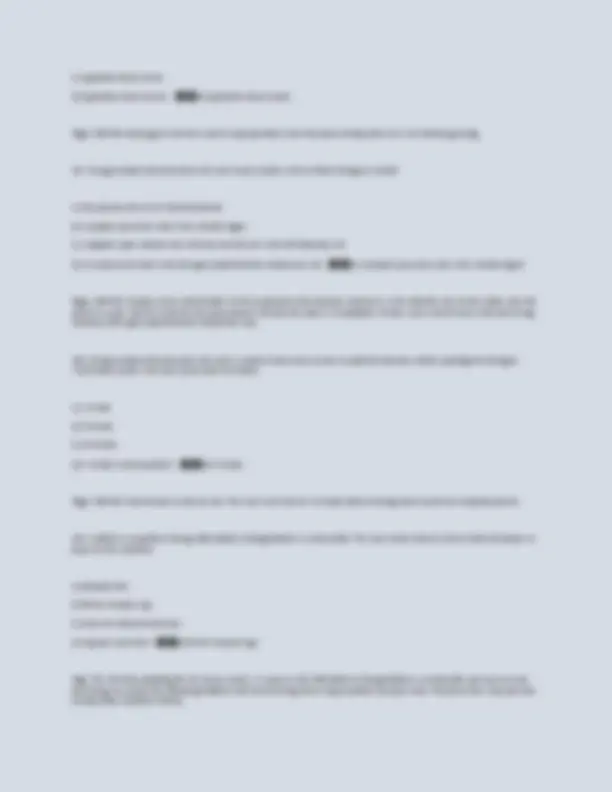
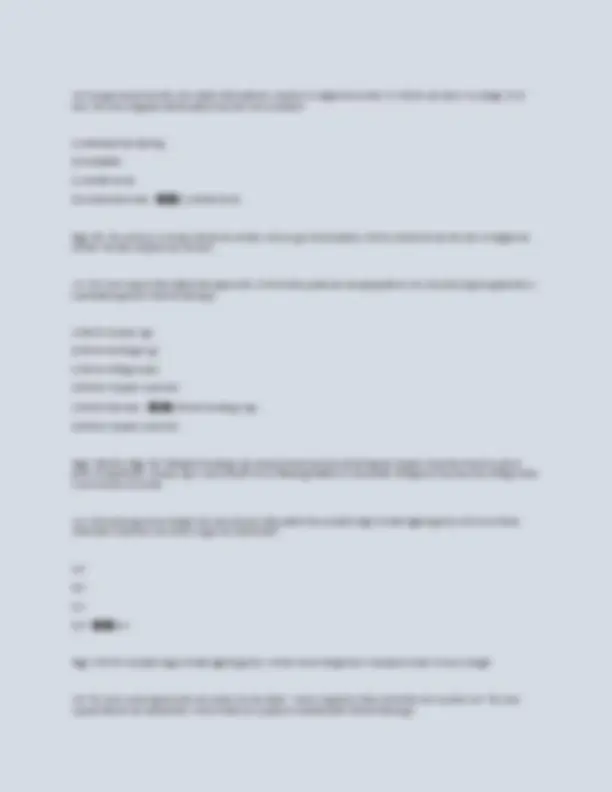

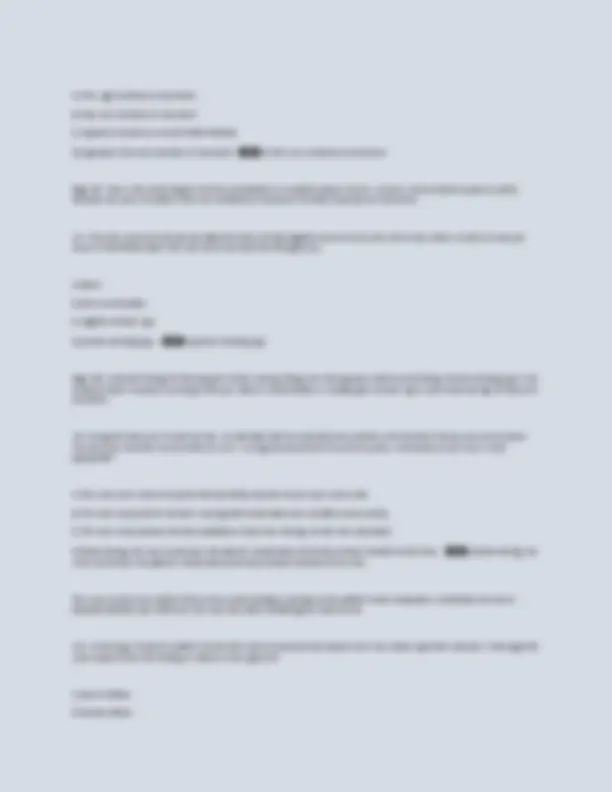




Study with the several resources on Docsity

Earn points by helping other students or get them with a premium plan


Prepare for your exams
Study with the several resources on Docsity

Earn points to download
Earn points by helping other students or get them with a premium plan
Community
Ask the community for help and clear up your study doubts
Discover the best universities in your country according to Docsity users
Free resources
Download our free guides on studying techniques, anxiety management strategies, and thesis advice from Docsity tutors
1. In an interview, the nurse may find it necessary to take notes to aid his or her memory later. Which statement is true regarding note-taking? A) Note-taking may impede the nurse's observation of the patient's nonverbal behaviors. B) Note-taking allows the patient to continue at his or her own pace as the nurse records what is said. C) Note-taking allows the nurse to shift attention away from the patient, resulting in an increased comfort level. D) Note-taking allows the nurse to break eye contact with the patient, which may increase his or her level of comfort. - ☑️☑️A) Note-taking may impede the nurse's observation of the patient's nonverbal behaviors. Page: 31 Some use of history forms and note-taking may be unavoidable. But be aware that note-taking during the interview has disadvantages. It breaks eye contact too often, and it shifts attention away from the patient,
Typology: Exams
1 / 38

This page cannot be seen from the preview
Don't miss anything!































A) Note-taking may impede the nurse's observation of the patient's nonverbal behaviors.
B) Note-taking allows the patient to continue at his or her own pace as the nurse records what is said.
C) Note-taking allows the nurse to shift attention away from the patient, resulting in an increased comfort level.
D) Note-taking allows the nurse to break eye contact with the patient, which may increase his or her level of comfort. - ☑️ ☑️ A) Note-taking may impede the nurse's observation of the patient's nonverbal behaviors.
Page: 31 Some use of history forms and note-taking may be unavoidable. But be aware that note-taking during the interview has disadvantages. It breaks eye contact too often, and it shifts attention away from the patient, which diminishes his or her sense of importance. It also may interrupt the patient's narrative flow, and it impedes the observation of the patient's nonverbal behavior.
A) Reflection
B) Facilitation
C) Direct question
D) Open-ended question - ☑️ ☑️ D) Open-ended question
Page: 32 The open-ended question asks for narrative information. It states the topic to be discussed but only in general terms. The nurse should use it to begin the interview, to introduce a new section of questions, and whenever the person introduces a new topic.
A) talking too much.
B) using confrontation.
C) using biased or leading questions.
D) using blunt language to deal with distasteful topics. - ☑️ ☑️ C) using biased or leading questions.
Page: 36 This is an example of using leading or biased questions. Asking, "You don't smoke, do you?" implies that one answer is "better" than another. If the person wants to please someone, he or she is either forced to answer in a way corresponding to their implied values or is made to feel guilty when admitting the other answer.
A) just changing positions.
B) more comfortable in this position.
C) tired and needs a break from the interview.
D) uncomfortable talking about his son's treatment. - ☑️ ☑️ D) uncomfortable talking about his son's treatment.
Page: 37 Note the person's position. An open position with the extension of large muscle groups shows relaxation, physical comfort, and a willingness to share information. A closed position with the arms and legs crossed tends to look defensive and anxious. Note any change in posture. If a person in a relaxed position suddenly tenses, it suggests possible discomfort with the new topic.
A) Determine the communication method he prefers.
B) Avoid using facial and hand gestures because most hearing-impaired people find this degrading.
C) Request a sign language interpreter before meeting with him to help facilitate the communication.
D) Speak loudly and with exaggerated facial movement when talking with him because this helps with lip reading. - ☑️ ☑️ A) Determine the communication method he prefers.
Pages: 40 - 41 The nurse should ask the deaf person the preferred way to communicate—by signing, lip reading, or writing. If the person prefers lip reading, then the nurse should be sure to face him or her squarely and have good lighting on the nurse's face. The nurse should not exaggerate lip movements because this distorts words. Similarly, shouting distorts the reception of a hearing aid the person may wear. The nurse should speak slowly and should supplement his or her voice with appropriate hand gestures or pantomime.
A) "Do you take medicine?"
B) "Do you sterilize the bottles?"
C) "Do you have nausea and vomiting?"
D) "You have been taking your medicine, haven't you?" - ☑️ ☑️ A) "Do you take medicine?"
Page: 46 In a situation where there is a language barrier and no interpreter available, use simple words avoiding medical jargon. Avoid using contractions and pronouns. Use nouns repeatedly and discuss one topic at a time.
A) A trained interpreter
A) Ask the patient about the item and its significance.
B) Ask the patient to lock the item with other valuables in the hospital's safe.
C) Tell the patient that a family member should take valuables home.
D) No action is necessary. - ☑️ ☑️ A) Ask the patient about the item and its significance.
Page: 21 The nurse should inquire about the amulet's meaning. Amulets, such as charms, are often seen as an important means of protection from "evil spirits" by some cultures.
A) have less efficient immune systems and are often ill.
B) consider these symptoms a part of normal living, not symptoms of ill health.
C) come from Mexico and coughing is normal and healthy there.
D) are usually in a lower socioeconomic group and are more likely to be sick. - ☑️ ☑️ B) consider these symptoms a part of normal living, not symptoms of ill health.
Page: 27 The nurse needs to identify the meaning of health to the patient, remembering that concepts are derived, in part, from the way in which members of the cultural group define health.
A) A person is able to work and produce.
B) A person is happy, stable, and feels good.
C) All aspects of the person are in perfect balance.
D) A person is able to care for others and function socially. - ☑️ ☑️ C) All aspects of the person are in perfect balance.
Page: 21 Many Asians believe in the yin/yang theory, in which health is believed to exist when all aspects of the person are in perfect balance. The other statements do not describe this theory.
A) germs and viruses.
B) supernatural forces.
C) eating imbalanced foods.
D) an imbalance within his or her spiritual nature. - ☑️ ☑️ B) supernatural forces.
Page: 21 The basic premise of the magicoreligious perspective is that the world is seen as an arena in which supernatural forces dominate. The fate of the world and those in it depends on the actions of supernatural forces for good or evil. The other answers do not reflect the magicoreligious perspective.
A) will comply with the treatment prescribed.
B) has obviously given up her beliefs in naturalistic causes of disease.
C) may also be seeking the assistance of a shaman or medicine man.
D) will need extra help in dealing with her illness and may be experiencing a crisis of faith. - ☑️ ☑️ C) may also be seeking the assistance of a shaman or medicine man.
Page: 23 When self-treatment is unsuccessful, the individual may turn to the lay or folk healing systems, to spiritual or religious healing, or to scientific biomedicine. In addition to seeking help from a biomedical or scientific health care provider, patients may also seek help from folk or religious healers.
A) contact the hospital administrator about the best course of action.
B) automatically get a curandero for her because it is not culturally appropriate for her to request one.
C) further assess the patient's cultural beliefs and offer the patient assistance in contacting a curandero or priest if she desires.
D) ask the family what they would like to do because Mexican-Americans traditionally give control of decisions to their families. - ☑️ ☑️ C) further assess the patient's cultural beliefs and offer the patient assistance in contacting a curandero or priest if she desires.
Pages: 22 - 23 In addition to seeking help from the biomedical/scientific health care provider, patients may also seek help from folk or religious healers. Some people, such as those of Mexican-American or American Indian origins, may believe that the cure is incomplete unless the body, mind, and spirit are also healed (although the division of the person into parts is a Western concept).
A) All patients will behave the same way when in pain.
B) Just as patients vary in their perceptions of pain, so will they vary in their expressions of pain.
C) Cultural norms have very little to do with pain tolerance, because pain tolerance is always biologically determined.
D) A patient's expression of pain is largely dependent on the amount of tissue injury associated with the pain. - ☑️ ☑️ B) Just as patients vary in their perceptions of pain, so will they vary in their expressions of pain.
A. has a history of drug abuse and therefore is not reliable.
B. provided consistent information and therefore is reliable.
C. smiled throughout interview and therefore is assumed reliable.
D. would not answer questions concerning stress and therefore is not reliable. - ☑️ ☑️ B. provided consistent information and therefore is reliable.
Page: 50. A reliable person always gives the same answers, even when questions are rephrased or are repeated later in the interview. The other statements are not correct.
A. Patient denies usual childhood illnesses.
B. Patient states he was a "very healthy" child.
C. Patient states sister had measles, but he didn't.
D. Patient denies measles, mumps, rubella, chickenpox, pertussis, and strep throat. - ☑️ ☑️ D. Patient denies measles, mumps, rubella, chickenpox, pertussis, and strep throat.
Page: 51. Childhood illnesses include measles, mumps, rubella, chickenpox, pertussis, and strep throat. Avoid recording "usual childhood illnesses" because an illness common in the person's childhood may be unusual today (e.g., measles).
A. "Maybe she is just teething."
B. "I will check her ear for an ear infection."
C. "Are you sure she is really having pain?"
D. "Please describe what she is doing to indicate she is having pain." - ☑️ ☑️ D. "Please describe what she is doing to indicate she is having pain."
Page: 60. With a very young child, ask the parent, "How do you know the child is in pain?" Pulling at ears alerts parent to ear pain. The statements about teething and questioning whether the child is really having pain do not explore the symptoms, which should be done before a physical examination.
A. The child's birth weight
B. The age at which he crawled
C. Whether he has had the measles
D. Reactions to previous hospitalizations - ☑️ ☑️ D. Reactions to previous hospitalizations
Assess how the child reacted to hospitalization and any complications. If the child reacted poorly, he or she may be afraid now and will need special preparation for the examination that is to follow. The other items are not significant for the procedure.
A. It assesses how the individual is coping with life at home.
B. It determines how children are meeting developmental milestones.
C. It can identify any problems with memory the individual may be experiencing.
D. It helps to determine how a person is managing day-to-day activities. - ☑️ ☑️ D. It helps to determine how a person is managing day-to-day activities.
Page: 67. The functional assessment measures how a person manages day-to-day activities. The other answers do not reflect the purpose of a functional assessment.
A. "Do you wear glasses?"
B. "Are you able to dress yourself?"
C. "Do you have any thyroid problems?"
D. "How many times a day do you have a bowel movement?" - ☑️ ☑️ B. "Are you able to dress yourself?"
Page: 67. Functional assessment measures how a person manages day-to-day activities. For the older person, the meaning of health becomes those activities that they can or cannot do. The other responses do not relate to functional assessment.
A. "How much junk food does your child eat?"
B. "How many teeth has he lost, and when did he lose them?"
C. "Is he able to tie his shoelaces?"
D. "Does he take a children's vitamin?"
E. "Can he tell time?"
F. "Does he have any food allergies?" - ☑️ ☑️ B. "How many teeth has he lost, and when did he lose them?"
Page: 73. The full mental status examination is a systematic check of emotional and cognitive functioning. The steps described here, though, rarely need to be taken in their entirety. Usually, one can assess mental status through the context of the health history interview.
A) "How do you feel today?"
B) "Would you please repeat the following words?"
C) "Have these medications had any effect on your pain?"
D) "Has this pain affected your ability to get dressed by yourself?" - ☑️ ☑️ A) "How do you feel today?"
Page: 74. Judge mood and affect by body language and facial expression and by asking directly, "How do you feel today?" or "How do you usually feel?" The mood should be appropriate to the person's place and condition and should change appropriately with topics.
A) "Do you feel that you are being watched, followed, or controlled?"
B) "Tell me about what you plan to do once you are discharged from the hospital."
C) "What does the statement, 'People in glass houses shouldn't throw stones,' mean to you?"
D) "What would you do if you found a stamped, addressed envelope lying on the sidewalk?" - ☑️ ☑️ B) "Tell me about what you plan to do once you are discharged from the hospital."
Pages: 76 - 77. A person exercises judgment when he or she can compare and evaluate the alternatives in a situation and reach an appropriate course of action. Rather than testing the person's response to a hypothetical situation (as illustrated in the option with the envelope), the nurse should be more interested in the person's judgment about daily or long-term goals, the likelihood of acting in response to delusions or hallucinations and the capacity for violent or suicidal behavior.
A) Mental status assessment diagnoses specific psychiatric disorders.
B) Mental disorders occur in response to everyday life stressors.
C) Mental status functioning is inferred through assessment of an individual's behaviors.
D) Mental status can be assessed directly, just like other systems of the body (e.g., cardiac and breath sounds). - ☑️ ☑️ C) Mental status functioning is inferred through assessment of an individual's behaviors.
Page: 71. Mental status functioning is inferred through assessment of an individual's behaviors. It cannot be assessed directly like characteristics of the skin or heart sounds.
A) palpation.
B) inspection.
C) percussion.
D) auscultation. - ☑️ ☑️ B) inspection.
Pages: 115 - 116. The skills requisite for the physical examination are inspection, palpation, percussion, and auscultation. The skills are performed one at a time and in this order (with the exception of the abdominal assessment, where auscultation takes place before palpation and percussion). The assessment of each body system begins with inspection. A focused inspection takes time and yields a surprising amount of information.
A) fingertips because they're more sensitive to small changes in temperature.
B) dorsal surface of the hand because the skin is thinner than on the palms.
C) ulnar portion of the hand because there is increased blood supply that enhances temperature sensitivity.
D) palmar surface of the hand because it is most sensitive to temperature variations because of increased nerve supply in this area. - ☑️ ☑️ B) dorsal surface of the hand because the skin is thinner than on the palms.
The dorsa (backs) of hands and fingers are best for determining temperature because the skin there is thinner than on the palms. Fingertips are best for fine, tactile discrimination; the other responses are not useful for palpation.
A) Avoid palpation of reported "tender" areas because this may cause the patient pain.
B) Quickly palpate a tender area to avoid any discomfort that the patient may experience.
C) Begin the assessment with deep palpation, encouraging the patient to relax and take deep breaths.
D) Start with light palpation to detect surface characteristics and to accustom the patient to being touched. - ☑️ ☑️ D) Start with light palpation to detect surface characteristics and to accustom the patient to being touched.
Pages: 115 - 116. Light palpation is performed initially to detect any surface characteristics and to accustom the person to being touched. Tender areas should be palpated last, not first.
A) Palpating the thorax of an infant
B) Palpating the kidneys and uterus
washed after gloves have been removed, even if the gloves appear to be intact. Gloves should be worn when there is potential contact with any body fluids.
A) When the infant is sleeping
B) At the end of the examination
C) Before auscultation of the thorax
D) Halfway through the examination - ☑️ ☑️ B) At the end of the examination
Page: 123. Elicit the Moro or "startle" reflex at the end of the examination because it may cause the infant to cry.
A) Auscultate the lungs and heart while the infant is still sleeping.
B) Examine the infant's hips because this procedure is uncomfortable.
C) Begin with the assessment of the eye and continue with the remainder of the examination in a head-to-toe approach.
D) Wake the infant before beginning any portion of the examination to obtain the most accurate assessment of body systems. - ☑️ ☑️ A) Auscultate the lungs and heart while the infant is still sleeping.
Pages: 122 - 124. When the infant is quiet or sleeping is an ideal time to assess the cardiac, respiratory, and abdominal systems. Assessment of the eye, ear, nose, and throat are invasive procedures and should be performed at the end of the examination.
A) An increase in body weight from younger years
B) Additional deposits of fat on the thighs and lower legs
C) The presence of kyphosis and flexion in the knees and hips
D) A change in overall body proportion, a longer trunk, and shorter extremities - ☑️ ☑️ C) The presence of kyphosis and flexion in the knees and hips
Page: 149. Changes that occur in the aging person include more prominent bony landmarks, decreased body weight (especially in males), a decrease in subcutaneous fat from the face and periphery, and additional fat deposited on the abdomen and hips. Postural changes of kyphosis and slight flexion in the knees and hips also occur.
A) is usually recorded on a 0 - to 2 - point scale.
B) demonstrates elasticity of the vessel wall.
C) is a reflection of the heart's stroke volume.
D) reflects the blood volume in the arteries during diastole. - ☑️ ☑️ C) is a reflection of the heart's stroke volume.
Page: 134. The heart pumps an amount of blood (the stroke volume) into the aorta. The force flares the arterial walls and generates a pressure wave, which is felt in the periphery as the pulse.
A) "When did the pain start?"
B) "Is the pain a stabbing pain?"
C) "Is it a sharp pain or dull pain?"
D) "What does your pain feel like?" - ☑️ ☑️ D) "What does your pain feel like?"
Page: 164. To assess the quality of a person's pain, have the patient describe the pain in his or her own words.
A) The absorption of nutrients may be impaired.
B) The constipation may represent a food allergy.
C) She may need emergency surgery for the problem.
D) The gastrointestinal problem will increase her caloric demand. - ☑️ ☑️ A) The absorption of nutrients may be impaired.
Page: 182. Gastrointestinal symptoms such as vomiting, diarrhea, or constipation may interfere with nutrient intake or absorption. The other responses are not correct.
A) Certain drugs can affect the metabolism of nutrients.
B) The nurse needs to assess the patient for allergic reactions.
C) Medications need to be documented on the record for the physician's review.
D) Medications can affect one's memory and ability to identify food eaten in the last 24 hours. - ☑️ ☑️ A) Certain drugs can affect the metabolism of nutrients.
Page: 191. Height measures may not be accurate in individuals confined to a bed or wheelchair or those over 60 years of age because of osteoporotic changes.
A) slowed gastrointestinal motility.
B) hyperstimulation of the salivary glands.
C) an increased sensitivity to spicy and aromatic foods.
D) decreased gastrointestinal absorption causing esophageal reflux. - ☑️ ☑️ A) slowed gastrointestinal motility.
Page: 176. Normal physiological changes in aging adults that affect nutritional status include slowed gastrointestinal motility, decreased gastrointestinal absorption, diminished olfactory and taste sensitivity, decreased saliva production, decreased visual acuity, and poor dentition.
A) support systems.
B) circulatory status.
C) socioeconomic status.
D) psychological wellness. - ☑️ ☑️ B) circulatory status.
Page: 211. The skin holds information about the body's circulation, nutritional status, and signs of systemic diseases as well as topical data on the integument itself.
A) Color variation
B) Border regularity
C) Symmetry of lesions
D) Diameter less than 6 mm - ☑️ ☑️ A) Color variation
Pages: 212 - 213. Abnormal characteristics of pigmented lesions are summarized in the mnemonic ABCD: asymmetry of pigmented lesion, border irregularity, color variation, and diameter greater than 6 mm.
A) Smooth mucous membranes and lips
B) Dry mucous membranes and cracked lips
C) Pale mucous membranes
D) White patches on the mucous membranes - ☑️ ☑️ B) Dry mucous membranes and cracked lips
Page: 215. With dehydration, mucous membranes look dry and lips look parched and cracked. The other responses are not found in dehydration.
A) Anasarca
B) Scleroderma
C) Pedal erythema
D) Clubbing of the nails - ☑️ ☑️ D) Clubbing of the nails
Pages: 217 - 218. Clubbing of the nails occurs with congenital cyanotic heart disease, neoplastic, and pulmonary diseases. The other responses are assessment findings not associated with pulmonary diseases.
A) Severe obesity
B) Childhood growth spurts
C) Severe dehydration
D) Connective tissue disorders such as scleroderma - ☑️ ☑️ C) Severe dehydration
Page: 215. Decreased skin turgor is associated with severe dehydration or extreme weight loss.
A) tell the patient to watch the lesion and report back in 2 months.
B) refer the patient because of the suspicion of melanoma on the basis of her symptoms.
C) ask additional questions regarding environmental irritants that may have caused this condition.
D) suspect that this is a compound nevus, which is very common in young to middle-aged adults. - ☑️ ☑️ B) refer the patient because of the suspicion of melanoma on the basis of her symptoms.
A) Positive Macewen sign
B) Premature closure of the sagittal suture
C) Headache, vertigo, tinnitus, and deafness
D) Elongated head with heavy eyebrow ridge - ☑️ ☑️ C) Headache, vertigo, tinnitus, and deafness
Paget's disease occurs more often in males and is characterized by bowed long bones, sudden fractures, and enlarging skull bones that press on cranial nerves causing symptoms of headache, vertigo, tinnitus, and progressive deafness.
A) cachexia.
B) Parkinson's syndrome.
C) myxedema.
D) scleroderma. - ☑️ ☑️ C) myxedema.
Pages: 276 - 277. Myxedema (hypothyroidism) is a deficiency of thyroid hormone that, when severe, causes a nonpitting edema or myxedema. The patient will have a puffy edematous face especially around eyes (periorbital edema), coarse facial features, dry skin, and dry, coarse hair and eyebrows. See Table 13 - 4, Abnormal Facial Appearances with Chronic Illnesses, for descriptions of the other responses.
A) pulled to the affected side.
B) pushed to the unaffected side.
C) pulled downward.
D) pulled downward in a rhythmic pattern. - ☑️ ☑️ B) pushed to the unaffected side.
Pages: 262 - 263. The trachea is pushed to the unaffected side with an aortic aneurysm, a tumor, unilateral thyroid lobe enlargement, and pneumothorax. The trachea is pulled to the affected side with large atelectasis, pleural adhesions, or fibrosis. Tracheal tug is a rhythmic downward pull that is synchronous with systole and occurs with aortic arch aneurysm.
A) Rickets
B) Dehydration
C) Mental retardation
D) Increased intracranial pressure - ☑️ ☑️ B) Dehydration
Pages: 265 - 266. Depressed and sunken fontanels occur with dehydration or malnutrition. Mental retardation and rickets have no effect on fontanels. Increased intracranial pressure would cause tense or bulging, and possibly pulsating fontanels.
A) allergies.
B) a sinus infection.
C) nasal congestion.
D) an upper respiratory infection. - ☑️ ☑️ A) allergies.
Page: 275. Chronic allergies often develop chronic facial characteristics. These include blue shadows below the eyes, a double or single crease on the lower eyelids, open-mouth breathing, and a transverse line on the nose.
A) "Vision is not totally developed until 2 years of age."
B) "Infants develop the ability to focus on an object at around 8 months."
C) "By about 3 months, infants develop more coordinated eye movements and can fixate on an object."
D) "Most infants have uncoordinated eye movements for the first year of life." - ☑️ ☑️ C) "By about 3 months, infants develop more coordinated eye movements and can fixate on an object."
Page: 284. Eye movements may be poorly coordinated at birth, but by 3 to 4 months of age, the infant should establish binocularity and should be able to fixate on a single image with both eyes simultaneously.
A) A decrease in tear production
B) Unequal pupillary constriction in response to light
C) The presence of arcus senilis seen around the cornea
D) Loss of the outer hair on the eyebrows due to a decrease in hair follicles - ☑️ ☑️ B) Unequal pupillary constriction in response to light
Pages: 305 - 308. Pupils are small in old age, and the pupillary light reflex may be slowed, but pupillary constriction should be symmetric. The assessment findings in the other responses are considered normal in older persons.